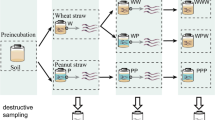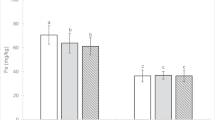Abstract
Presently, more than 85% of the broiler chicken (Gallus gallus domesticus) litter (BCL) is being applied to pasture lands year-round. This practice results in nutrient losses and potentially unfavorable environmental impacts particularly during the wet winter months. A field plot experiment was initiated in 2001 on a Ruston silt loam in Mize, MS to identify the proper BCL application timing that enhances BCL nutrient uptake by crops while minimizing undesirable nutrient buildup in soil. Seven treatments (BCL application timings) were employed on previously established “Coastal” hybrid bermudagrass [Cynodon dactylon (L.) Pers.] plots. For each treatment, the quantity of broiler chicken litter (a mixture of chicken manure plus bedding materials) needed for each plot was calculated based on the BCL total N content to provide 400 kg N ha−1 for top bermudagrass yield (18 Mg ha−1) and applied either as a single, two-way split, or three-way split at different dates as follow: May; May/June; April/May/June; May/June/July; June/July/August; July/August/September; and August/September/October. Bermudagrass was harvested 5 times each year for dry matter (DM) and nutrient uptake determination. Significant differences in DM yield were observed in each year among application timings. The greatest DM yield was 18.6 Mg ha−1 for the single application in May and lowest at 15.0 Mg ha−1 for Aug/Sep/Oct application dates in 2001 and followed by the same trend in 2002. The N and P uptake by bermudagrass ranged from 270 to 381, and 53 to 63 kg ha−1 respectively, in 2001. Similar trend, but lower values for nutrient uptake were observed in 2002. Significant differences were observed among BCL application timings in regard to soil residual of total carbon (TC), total nitogen (TN), Mehlich 3 extracted P (M3-P), NO3–N, Cu, and Fe elements at the end of the study. In general, summer and early fall BCL applications resulted in greater buildup of most of these elements. Based on the results of this study, there is a wide window (May–July) for BCL application timing on bermudagrass considering the criteria of producing high yield and low soil residual nutrient. However, the best BCL application timing should be in spring (late April–June) when minimum temperatures exceed those required (24–27°C) for bermudagrass growth.



Similar content being viewed by others
References
Ball DM, Hoveland CS, Lacefield GD (1991) Southern forages. Potash and Phosphate Inst. and Foundation for Agron. Res., Norcross
Beard JB (1973) Turfgrass: science and culture. Prentice Hall, Englewood Cliffs
Brink GE, Rowe DE, Sistani KR (2002) Broiler litter application effects on yield and nutrient uptake of ‘Alicia’ Bermudagrass. Agron J 94:911–916
Brink GE, Rowe DE, Sistani KR, Adeli A (2003) Bermudagrass cultivar response to swine effluent application. Agron J 95:597–601
Brink GE, Sistani KR, Rowe DE (2004) Nutrient uptake of hybrid and common bermudagrass fertilized with broiler litter. Agron J 96:1509–1515
Brinson SE, Cabrera ML, Tyson SC (1994) Ammonia volatilization from surface-applied fresh and composted poultry litter. Plant Soil 167:213–218
Burns JC, Westernman PW, King LD, Cummings GA, Overcash MR, Goode L (1985) Swine lagoon effluent applied to coastal bermudagrass: I. Forage yield, quality, and Element Removal. J Environ Qual 14:9–14
Burton GW, Hanna WW (1995) Bermudagrass. In Barnes RF et al (eds) Forages: an introduction to grassland agriculture, vol 1. Iowa State University Press, Ames, pp 421–430
Daniel TC, Sharpley A, Edwards DR, Wedepohl R, Lemunyon JL (1994) Minimizing surface water eutrophication from agriculture by phosphorus management. J Soil Water Conserv 49:30–38
Evers GW (1998) Comparison of broiler poultry litter and commercial fertilizer for coastal bermudagrass production in the Southeastern U.S J Sust Agric 12:55–77
Geohring LD, McHugh OV, Walter MT, Steenhuis TS, Akhtar MS, Walter MF (2001) Phosphorus transport into subsurface drains by macropores after manure applications: implication for best manure management practices. Soil Sci 166:896–909
Gilley JE, LM Risse, Eghball B (2002) Runoff and soil loss as affected by the application of manure. Trans ASAE 43:1583–1588
Kuo S (1996) Phosphorus. In: Bigham JM (ed) Methods of soil analysis, Part 3, Agronomy No. 5. Soil Science Society of America, Inc. ASA, Madison, pp 869–874
McLaughlin MR, Fairbrother TE, Rowe DE (2004) Nutrient uptake by warm-season perennial grasses in a swine effluent spray field. Agron J 96:484–493
McLaughlin MR, Sistani KR, Fairbrother TE, Rowe DE (2005) Overseeding common bermudagrass with cool-season annuals to Increase yield and nitrogen and phosphorus uptake in a hay field fertilized with swine effluent. Agron J 97:487–493
Mehlich A (1984) Mehlich 3 soil test extractant. Commun Soil Sci Plant Anal 15:1409–1416
Mulvaney RL (1996) Nitrogen-inorganic forms. In Bigham JM (ed) Methods of soil analysis, Part 3, Agronomy No. 5. Soil Science Society of America, Inc. ASA, Madison, pp 1123–1131
Overman AR, Sanderson MA, Jones RM (1993) Logistic response of bermudagrass and bunchgrass cultivars to applied nitrogen. Agron J 85:541–545
Pant HK, Adjei MB, Scholberg JMS, Chambliss CG, Rechcigl JE (2004) Forage production and phosphorus phytoremediation in manure-impacted soils. Agron J 96:1780–1786
Pote DH, Kingery WL, Aiken GE, Han FX, Moore PA Jr, Buddington K (2003) Water-quality effects of incorporating poultry litter into perennial grassland soils. J Environ Qual 32:2392–2398
Read JJ, Brink GE, Oldham JL, Kingery WL, Sistani KR (2006) Effects of broiler litter and nitrogen fertilization on uptake of major nutrients by coastal bermudagrass. Agron J 98:1065–1072
Sauer TJ, Daniel TC, Nichols DJ, West CP, Moore PA Jr, Wheeler GL (2000) Runoff water quality from poultry litter-treated pasture and forest sites. J Environ Qual 29:515–521
SAS Institute (1999) SAS/STAT user’s guide. Version 8. SAS Institute, Cary
Sharpley AN, Chapra SC, Wedepohl R, Sims JT, Daniel TC, Reddy KR (1994) Managing agricultural phosphorus for protection of surface water: issues and options. J Environ Qual 23:437–451
Simrad RR, Cluis D, Gangbazo G, Beauchemin S (1995) Phosphorus status of forest and agricultural soils from a watershed of high animal density. J Environ Qual 24:1010–1017
Sims JT (1995) Characteristics of animal waste and waste-amended soils: an overview of the agricultural and environmental issues. In: Steele K (ed) Animal waste and the land-water interface. CRC Press, Boca Raton, pp 1–14
Sims JT, Simrad RR, Joern BC (1998) Phosphorus loss in agricultural drainage: historical perspective and current research. J Environ Qual 27:277–293
Sistani KR, Brink GE, Adeli A, Tewolde H, Rowe DE (2004) Year-round soil nutrient dynamics from broiler litter application to three bermudagrass cultivars. Agron J 96:525–530
Southern Cooperative Series (1983) Reference soil test methods for the southern region of the United States. Southern cooperative series, Bulletin No. 289. Georgia Agric. Exp. Stn., Athens
Van Es HM, Schindelbeck RR, Jokela WE (2004) Effects of manure application timing, crop, and soil type on phosphorus leaching. J Environ Qual 33:1070–1080
Author information
Authors and Affiliations
Corresponding author
Rights and permissions
About this article
Cite this article
Sistani, K.R., Adeli, A., Tewolde, H. et al. Broiler chicken litter application timing effect on Coastal bermudagrass in southeastern U.S.. Nutr Cycl Agroecosyst 81, 49–57 (2008). https://doi.org/10.1007/s10705-007-9150-2
Received:
Accepted:
Published:
Issue Date:
DOI: https://doi.org/10.1007/s10705-007-9150-2




